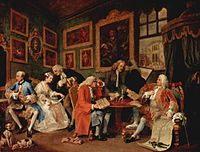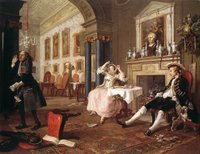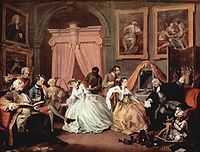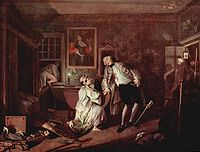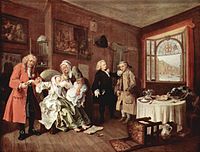- Marriage à-la-mode (Hogarth)
-
In 1743–1745, William Hogarth painted the six pictures of Marriage à-la-mode (National Gallery, London), a pointed skewering of upper class 18th century society. This moralistic warning shows the disastrous results of an ill-considered marriage for money. This is regarded by many as his finest project, certainly the best example of his serially-planned story cycles.
Contents
General commentary
In Marriage à-la-mode, Hogarth challenges the ideal view that the rich live virtuous lives with a heavy satire on the notion of arranged marriages. In each piece, he shows the young couple and their family and acquaintances at their worst: engaging in affairs, drinking, gambling, and numerous other vices..
- In the first of the series, he shows an arranged marriage between the son of bankrupt Earl Squanderfield and the daughter of a wealthy but miserly city merchant. The son looks indifferent while the merchant's daughter is distraught and has to be consoled by the lawyer Silvertongue.
- In the second, there are signs that the marriage has already begun to break down. The husband and wife appear uninterested in one another, amidst evidence of their separate overindulgences the night before.
- The third in the series shows the Viscount visiting a quack with a young prostitute. The viscount, unhappy with the mercury pills meant to cure his syphilis, demands a refund while the young prostitute next to him dabs an open sore on her mouth, an early sign of syphilis.
- In the fourth, the old Earl has died and the son is now the new Earl and his wife, the Countess. As was the very height of fashion at the time, the Countess is holding a "Toilette", or reception, in her bedroom. The lawyer Silvertongue from the first painting is reclining next to the Countess, suggesting the existence of an affair. This point is furthered by the child in front of the pair, pointing to the horns on the statue of Actaeon, a symbol of cuckoldry. Paintings in the background include the biblical story of Lot and his daughters, Jupiter and Io, and the rape of Ganymede.[1]
- Next, the new Earl catches his wife in a bagnio with her lover, the lawyer, and is fatally wounded by the lawyer. As she begs forgiveness from the stricken man, the murderer in his nightshirt makes a hasty exit through the window. A picture of a woman with a squirrel on her hand hanging behind the countess contains lewd undertones.[2]
- Finally the Countess poisons herself in her grief and poverty-stricken widowhood, after her lover is hanged at Tyburn for murdering her husband. An old woman carrying her baby allows the child to give her a kiss, but the mark on her cheek and the caliper on her leg suggest that disease has been passed onto the next generation.
These pictures were at first poorly received by the public, to the great disappointment of the artist. He sold them to a Mr. Lane of Hillington for one hundred and twenty guineas. The frames alone had cost Hogarth four guineas each, so his initial remuneration for painting this valuable series was only sixteen shillings over a hundred pounds. From Mr. Lane's estate, they became the property of his nephew, Colonel Cawthorn, who very highly valued them. In the year 1797 they were sold by auction at Christie's, Pall Mall, for the sum of one thousand guineas; the liberal purchaser was John Julius Angerstein. They are now owned by the British government and part of the collection of the National Gallery.
It had been Hogarth's intention to follow the Marriage à-la-mode series with a companion series called The Happy Marriage, however, this series was never completed and only exists as a series of unfinished sketches. Hogarth's loss of interest was probably because a conventional and happy marriage gave little opportunity for barbed and ironic treatment of events.
Technical commentary
Although this series of paintings are works of art in their own right, their original purpose was to provide the subjects for the series of engraved copper plate prints. By the nature of the process, when engraving copper plates, the image engraved on the plate by the engraver is reversed, that is to say, a mirror image of the final print. Normally, when undertaking paintings that are to be engraved, the painting is produced the "right way round" — not reversed — and then the engraver views it in a mirror as he undertakes the engraving. Hogarth was an engraver himself and disliked this course of action using mirrors, so unusually, he produced the paintings for Marriage à-la-mode already reversed so the engraver could directly copy them.
It would normally be expected to view the series of prints moving from left to right and Hogarth would have taken this into account when composing the original paintings.
Naming
Commentators have used a variety of names for the individual paintings, but as the paintings are presently in the National Gallery the names used there are used here.
See also
- A Harlot's Progress (1732)
- A Rake's Progress (1735)
References
Bibliography
- The Other Hogarth, eds. Bernadette Fort and Angela Rosenthal, Princeton: Princeton University Press, 2001.
External links
Categories:- William Hogarth paintings and prints
- 1740s paintings
- Collections of the National Gallery, London
- Painting series
Wikimedia Foundation. 2010.

